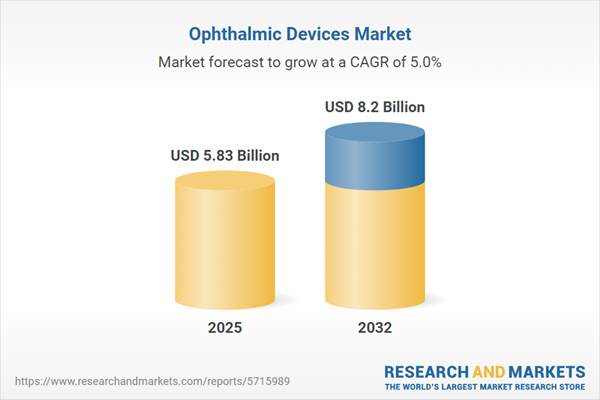Speak directly to the analyst to clarify any post sales queries you may have.
Senior decision-makers in ophthalmology require actionable market intelligence to adapt to rapid advances, emerging technologies, and shifting procurement landscapes in the ophthalmic devices sector. This overview delivers the clarity needed to inform strategic plans and support organizational resilience in a dynamic healthcare marketplace.
Market Snapshot of the Ophthalmic Devices Market
The ophthalmic devices market demonstrated steady growth, expanding from USD 5.56 billion in 2024 to USD 5.83 billion in 2025, representing a 4.97% compound annual growth rate. Forward projections estimate the sector will reach USD 8.20 billion by 2032. This growth is fueled by the digitalization of diagnostic and surgical workflows, which is transforming clinical needs and procurement policies across global healthcare systems. The integration of advanced medical technologies is prompting healthcare providers to revisit established purchasing models and increasing the importance of compliance as regulatory frameworks evolve internationally.
Scope & Segmentation in the Ophthalmic Devices Market
This report offers comprehensive analysis tailored for senior leadership, examining industry trends, competitor dynamics, and emerging opportunities. These insights enhance alignment with evolving market priorities and support data-driven strategic decisions at every organizational level.
- Product Types: Includes a full spectrum of diagnostic and monitoring devices such as fundus cameras, ophthalmoscopes, coherence tomography scanners, pachymeters, perimeters, retinoscopes, and wavefront aberrometers, recognized for supporting higher clinical precision. Surgical devices address broad clinical needs, from cataract and glaucoma operations to refractive error correction, incorporating both laser and phacoemulsification technologies for routine and complex procedures.
- Application Areas: Encompasses solutions for cataract management, dry eye disease, glaucoma, refractive surgery, and vitreoretinal interventions. These applications reflect changing treatment protocols and the adoption of more efficient patient management models.
- End-Users: Addresses varied utilization strategies among ambulatory surgery centers, hospitals, ophthalmic clinics, optical retailers, research faculties, academic institutions, and specialty eye clinics—all playing vital roles in influencing procurement and technology adoption.
- Regional Analysis: Delivers extensive geographic coverage, incorporating North America, Latin America, Europe, the Middle East, Africa, and Asia-Pacific. This regional breadth accounts for distinct healthcare infrastructures, diverse economic contexts, and varied regulatory environments.
- Leading Companies: Features strategic analysis of competitive participants, including Alcon Inc., Bausch & Lomb Incorporated, Canon Medical Systems Corporation, Carl Zeiss AG, ClearSight, Diamatrix Ltd., Essilor International S.A., Eyenovia, Inc., F. Hoffmann-La Roche AG, GWS Surgicals LLP, Haag-Streit Group by Metall Zug, Halma PLC, HEINE Optotechnik, Luneau Technology Operations SAS, Nidek Co. Ltd., Ophtec B.V., Ophtechnics Unlimited, Paramount Surgimed Ltd., Quantel Medical, Topcon Corporation, and Ziemer Ophthalmic Systems AG. Each contributes to evolving procurement dynamics, innovation uptake, and value-added services.
Key Takeaways for Senior Decision-Makers
- Integrating digital health tools with ophthalmic devices enhances their alignment with modern health record systems and supports scalable teleophthalmology platforms.
- Artificial intelligence and analytics adoption raise diagnostic capabilities and enable more personalized treatment planning, driving improved clinical outcomes and streamlined workflows.
- Device miniaturization and robotics contribute to minimally invasive surgical methods, building consistency and allowing greater patient throughput across care settings.
- Agility in compliance management is essential to respond to changing regulatory and reimbursement guidelines in diverse regional markets, helping contain operational and financial exposure.
- Collaboration among healthcare providers, technology developers, and academic stakeholders supports ongoing innovation and encourages the transition to value-based care delivery.
- Solutions tailored to varying requirements—from academic research centers to specialty clinics—are critical for supporting extended service needs and niche applications.
Tariff Impact on Supply Chains and Accessibility
Shifts in tariff regulations are driving ophthalmic device manufacturers to reassess production and distribution networks. Regionalized manufacturing is gaining focus to manage cost exposure and strengthen supply chain continuity. Procurement and supply chain leaders are refining sourcing, contract management, and inventory protocols to adapt to volatility and maintain consistent market access across key geographies.
Methodology & Data Sources
This report synthesizes direct input from industry participants with rigorous secondary research, including peer-reviewed publications and regulatory reviews. By applying transparent and uniform data standards, these findings provide reliable insights into procurement practices, technology adoption, and regulatory impacts within the ophthalmic devices market.
Why This Report Matters
- Supports leadership teams in refining product and sourcing strategies as clinical practices and operational requirements evolve.
- Provides actionable benchmarks for risk mitigation and procurement agility amid regulatory and competitive change.
- Enables executives to anticipate shifts in technology and compliance, enhancing organization-wide resilience and long-term growth prospects.
Conclusion
Senior executives gain clear, actionable intelligence from this report to elevate strategy, improve compliance, and enhance competitive agility in the ophthalmic devices market as new challenges and opportunities emerge.
Additional Product Information:
- Purchase of this report includes 1 year online access with quarterly updates.
- This report can be updated on request. Please contact our Customer Experience team using the Ask a Question widget on our website.
Table of Contents
3. Executive Summary
4. Market Overview
7. Cumulative Impact of Artificial Intelligence 2025
List of Figures
Samples

LOADING...
Companies Mentioned
The key companies profiled in this Ophthalmic Devices market report include:- Alcon Inc.
- Bausch & Lomb Incorporated
- Canon Medical Systems Corporation
- Carl Zeiss AG
- ClearSight
- Diamatrix Ltd.
- Essilor International S.A.
- Eyenovia, Inc.
- F. Hoffmann-La Roche AG
- GWS Surgicals LLP
- Haag-Streit Group by Metall Zug
- Halma PLC
- HEINE Optotechnik
- Luneau Technology Operations SAS
- Nidek Co. Ltd.
- Ophtec B.V.
- Ophtechnics Unlimited
- Paramount Surgimed Ltd.
- Quantel Medical
- Topcon Corporation
- Ziemer Ophthalmic Systems AG
Table Information
| Report Attribute | Details |
|---|---|
| No. of Pages | 190 |
| Published | October 2025 |
| Forecast Period | 2025 - 2032 |
| Estimated Market Value ( USD | $ 5.83 Billion |
| Forecasted Market Value ( USD | $ 8.2 Billion |
| Compound Annual Growth Rate | 4.9% |
| Regions Covered | Global |
| No. of Companies Mentioned | 22 |









